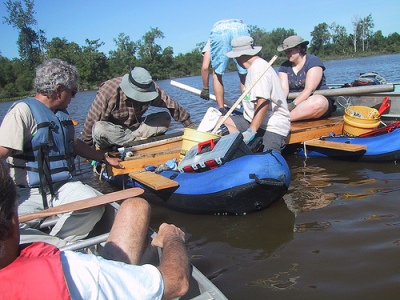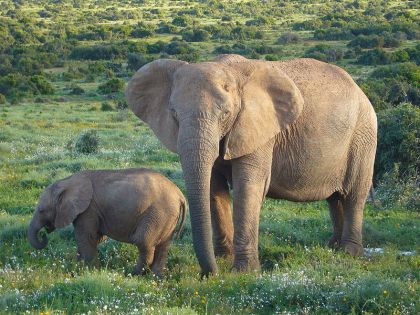Paleoecological research involves equal parts detective work, mental time-travel, and story-telling. Clues from the past are collected and pieced together to map out what landscapes might have looked like, and how they may have changed through time. It’s not unlike walking through the set of a play after all the characters are gone, and half the props are missing; the trick is to find enough of the right evidence to tell a convincing story that best fits your data. I am a paleoecologist, and here is a story:
More than seventeen thousand years ago, central Ohio was just emerging from beneath the melting ice sheet that had covered half of North America during the last ice age. Imagine yourself in this newly deglaciated landscape: rivers of meltwater snake through sand and gravel, around boulders and stagnant blocks of ice left behind by the melting glacier. One such block, covered over by debris, slowly melts; when it finally collapses, it forms a kettle-shaped basin that fills with water. Thousands of years later, someone will call it Silver Lake.

Glacial meltwater and debris from Mount Edith Cavell Glacier. Photo by Wing-Chi Poon, Creative Commons.
The first trees appear; clumps of spruce trees dotting an open, parkland-like landscape of grass and sedges. Mammoths graze the open spaces, and mastodons pull the tender leaves off of small saplings. Things are changing rapidly; the climate swings from the cold, dry ice age conditions to warmer and wetter, only to swing back again one last time before finally transitioning to the warmer conditions of the Holocene (the inter-glacial we live in today). The landscape becomes more diverse as alder, tamarack and other trees arrive from their ice-age refuges, establishing when their offspring are lucky enough to disperse into a suitable habitat. Meanwhile, the first humans arrive, and witness much of this change; perhaps they add some changes of their own, as they hunt, gather, disperse seeds, and set fires.
Then, in the blink of a geologic eye, the mammoths are gone. So are the horses, camels, giant beavers, saber-toothed cats and short-faced bears; by twelve thousand years ago, more than half the animals larger than a German shepherd have disappeared from the landscape. The double threat of a changing climate and new hunting pressures packs a mighty punch; a continent that once held more large mammal diversity than the African savanna is left with just a few species of large herbivores.
Cue a young scientist, working on her PhD nearly twelve thousand years later. She’s interested not so much in why the mammoths went extinct, but in what came afterwards. What happens when you take an entire guild of animals out of a landscape in a geologic instant? The mammoths, mastodons, and other herbivores have been residents of North America for millennia; other megafauna, like horses and camels, actually originated here. Did the landscapes they left behind remember them?

Collecting the sediment core from Silver Lake, OH in 2007. The mud is the archive of past landscape change.
I address this question in a new paper*, which came out in Quaternary Science Reviews this week (Gill et al. 2012). This study is a chapter of my PhD research, which followed up on my masters thesis on the ecological impacts of the extinction of ice-age herbivores (Ed Yong has a nice summary of my previous paper here). We used the pollen, charcoal, and physical properties preserved in the mud at the bottom of Silver Lake to reconstruct changing ecosystems after the lake was formed. To determine the timing of the megafaunal extinction, I counted spores from a dung fungus, Sporormiella, that requires digestion by herbivores to complete its life cycle. (lots of spores = lots of dung = lots of herbivores). In this paper, we argue that the loss of ice-age herbivores contributed to long-term changes in plant communities, including the emergence of novel ecosystems. By “novel,” or “no-analog,” we mean that the plant communities following the extinction of the megaherbivores were unlike any we’d see on the landscape in North America today. They consisted of unusual combinations of trees like spruce and ash that you’d normally find in cold boreal and warmer deciduous forests, respectively– two totally different biomes that don’t have a lot of overlapping tree species.
If the mammoths and giant beaver were extinct, how could they have had anything to do with the formation of new ecosystems? In our paper, we argue that these communities arose as the result of both changing climates and the loss of herbivores. In other words, herbivores may have preferred the tastier, more easily-digestible and nutritious deciduous trees, which were then able to thrive after they were no longer on the menu. Large herbivores not only affect ecosystems through consuming plants, though. We also suggest that once the herbivores went extinct, the plant material that would have been a mammoth dinner was instead able to accumulate on the landscape. This may have also had consequences to ecosystems: we found evidence that increasing the amount of plant litter in the forest may have 1) increased fire, because there was more more fuel available to burn, and 2) changed the way that nutrients like calcium cycled through the ecosystem. Plants and animals are often limited by the availability of nutrients in the soil, and so the loss of herbivores may have indirectly influenced what kinds of plants could thrive in the new conditions.

Elephants are important keystones in African savanna habitats, helping to maintain the balance between trees and grass. Photo in public domain.
The growing message from my dissertation research is that large herbivores are important. As ecological “keystones” that help maintain certain kinds of landscapes, losing our largest animals may have long-term consequences. The novel ecosystems following the megafaunal population collapse around Silver Lake lasted more than a thousand years! We know that large herbivores are some of the most threatened species today, and so their extinction (or conversely, their rewilding) may have cascading effects on ecosystems that can be difficult to predict. Extinction isn’t the only threat to modern ecosystems, however. I’m increasingly interested in how landscapes will respond to multiple changes that may interact to produce unpredictable results. At Silver Lake, the changes we observed are likely due to interactions between climate change and extinction; sounds familiar, doesn’t it?
What’s next? I’m currently wrapping up a study of the dung fungus Sporormiella, to better understand how well it predicts herbivore densities on modern landscapes and to strengthen our inferences from the paleo-record. Next up is a paper exploring the novel ecosystems of the Great Lakes region in greater detail, to help understand how these new landscapes are formed and how they behave. I’m also working on a model of the effects of ice-age herbivores on ecosystems like the one around Silver Lake, to model what I can’t observe in the wild. That should keep me busy until I complete my dissertation in May, right?
Gill, J. L., J. W. Williams, S. T. Jackson, J. P. Donnelly, & G. C. Schellinger. 2012. Climatic and megaherbivory controls on late-glacial vegetation dynamics: a new, high-resolution, multi-proxy record from Silver Lake, OH. Quaternary Science Reviews, doi: 10.1016/j.quascirev.2011.12.008
*Please email me at jacquelynlgill [at] gmail [dot] com if you would like a copy of any of my paper manuscripts.
Categories: Grad School Publications
Great post Jacquelyn! Congrats on the paper.
LikeLike
Thanks! I was also thinking it might be fun to do more than one post on a paper – you could do an in-depth analysis of the stats used, or talk about things that would be more relevant to an academic audience, or have a background/fieldwork post. I suppose it would make more sense to do a lot of that during the stages of a project, rather than all at once at the end. You could have a tag for a project so all of the posts were linked.
LikeLike
I really enjoyed your write-up of your paper for a broader audience; not being a scientist in this area, it really makes your research more accessible. This post is definitely making me think about writing about my own work in an accessible way, so thanks for that.
LikeLike
I haven’t read your paper yet, but what sort of timing offset are we talking about post-extinction to change in landscape? Also, you guys obtain radiocarbon dates on macrofossils in the core I presume?
Very cool post !
LikeLike
Good questions! The difference between the samples recording the megafaunal collapse (via dung fungus spores) and the emergence of novel plant communities is within a couple of decades, according to our age model. All of our dates are from radiocarbon-dated materials: wood, needles, and non-aquatic plants.
LikeLike
A couple of decades?! Wow. That’s crazy – much shorter than I expected. Also, do you think perhaps compound specific radiocarbon dates would be a better method to obtain accurate dates?
LikeLike
I’m not super familiar with compound-specific dates, but am intrigued! Our sediments of interest are late-glacial, so are low in organic content, and are also high in carbonates. Would those make compound-specific dating prohibitive? Are they expensive, relative to OM dates?
LikeLike
Hmmm, the low organic content may affect CSRA but you can get down to very small quantities for analysis. And yes, more expensive compared to normal dates. Here’s a neat review if you are interested: http://is.gd/nPnNnF
LikeLike
This is cool, thanks for writing about your own paper.
I’m wondering … to better evaluate the relative contributions of climate vs. megaherbivore extinction on landscape change, could other well-documented sites from this time period be analyzed and integrated in a comparative way? That is, perhaps there’s a site elsewhere on Earth where the megaherbivore extinction can be demonstrated to be earlier or later than Silver Lake, and, thus, used as another ‘run’ in the ‘experiment’ to test the influence of contributing factors.
Note: I haven’t looked at your paper, you may discuss my question in there.
LikeLike
This is a great question, and is definitely the goal– the “more sites!” refrain is common, and is in both of the papers I’ve written on this work. The one limiting factor is how much time it takes to reconstruct these records. Sporormiella is gaining traction, though, and more and more sites are being analyzed (both by our and other teams). There’s another study that shows similar patterns of extinction followed by vegetation and fire changes in Madagascar following human arrival (in a period without substantial climate change) in the late Holocene.
LikeLike